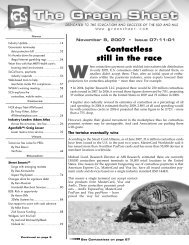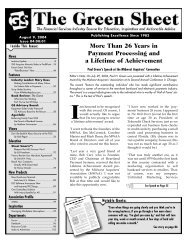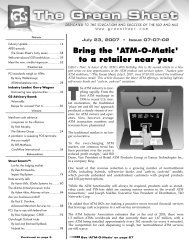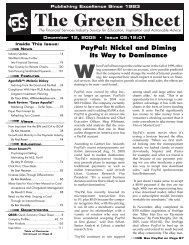View PDF of this issue - The Green Sheet
View PDF of this issue - The Green Sheet
View PDF of this issue - The Green Sheet
You also want an ePaper? Increase the reach of your titles
YUMPU automatically turns print PDFs into web optimized ePapers that Google loves.
82<br />
Education (continued)<br />
Go vertical,<br />
young ISO<br />
By Lane Gordon<br />
MerchantPortfolios.com<br />
<strong>The</strong> 2008 Electronic Transactions Association's<br />
Annual Meeting & Expo was very interesting.<br />
Of the many emerging angles we encountered in<br />
terms <strong>of</strong> the most sought-after acquisitions, there<br />
appeared to be one common theme: niche specialization.<br />
Being an industry insider and dealing with buyers and<br />
sellers every day, I have been accustomed to seeing a<br />
merchant portfolio's value enhanced through a broad<br />
spectrum <strong>of</strong> diversified Standard Industrial Classification<br />
codes, geographic locations, and a large component <strong>of</strong><br />
traditional brick-and-mortar businesses.<br />
But times are changing: Welcome to the dawn <strong>of</strong> enhanced<br />
value through nondiversification, specialization and ancillary<br />
products. Let's face it. <strong>The</strong> product that most ISOs are<br />
selling is a pure commodity.<br />
When you're selling a commodity for a living, the only<br />
way to take yourself out <strong>of</strong> the realm <strong>of</strong> competition based<br />
solely on pricing is to find a way to differentiate your<br />
product and services. Typically, <strong>this</strong> type <strong>of</strong> differentiation<br />
or enhanced value is sold to a merchant in the form <strong>of</strong> a<br />
higher level <strong>of</strong> quality customer support and or service.<br />
Essentially, ISOs are decommoditizing what basically is a<br />
homogenous product. Much <strong>of</strong> the value created by better<br />
customer support and service manifests itself in minimal<br />
losses <strong>of</strong> merchant accounts. Yes, that's right. Good old attrition<br />
maintenance (also known as retention) is the end game<br />
which creates value (especially in the eyes <strong>of</strong> a buyer).<br />
Successful ISOs have effectively managed to brand themselves<br />
or at the very least differentiate themselves from the<br />
pack. I've learned to have tremendous pr<strong>of</strong>essional respect<br />
for those who have managed to do that against all odds.<br />
<strong>The</strong> problem is that most <strong>of</strong> the other ISOs have become<br />
aware <strong>of</strong> <strong>this</strong> methodology, and what we're seeing now in<br />
the marketplace is a commoditization <strong>of</strong> high quality service<br />
and support, which has been the next level <strong>of</strong> differentiation<br />
in the ISO world beyond just superior pricing.<br />
This leaves the ISOs with several questions:<br />
• How do I differentiate my ISO now?<br />
• Where do we go from here?<br />
• How do I, once again, decommoditize my <strong>of</strong>fering to<br />
merchants?<br />
ISOs and processors are now looking toward all sorts<br />
<strong>of</strong> verticals and specialties. As an established ISO with<br />
a substantial base <strong>of</strong> merchant accounts, you've already<br />
successfully managed to push your way into the lives and<br />
day-to-day operations <strong>of</strong> your merchants.<br />
If you can successfully find ancillary <strong>of</strong>fice goods or services<br />
to <strong>of</strong>fer your merchants – that also generate recurring<br />
revenue – you can successfully leverage your existing<br />
merchant base and expand your revenue stream.<br />
For the same reason that accounting s<strong>of</strong>tware manufacturers<br />
have had interest in the processing and ISO world,<br />
we are seeing larger ISOs and processors now looking at<br />
related back-<strong>of</strong>fice products and services as a way to permanently<br />
entrench themselves with merchants.<br />
ISOs are researching specific verticals such as niche<br />
segments within various industries. ISOs are availing<br />
themselves <strong>of</strong> specific knowledge they may have within<br />
a certain sector, a technology piece that allows them to<br />
integrate into a niche market, or sometimes even the fact<br />
that they have implemented bilingual speakers into their<br />
service and tech support, allowing them to cross into<br />
what was previously considered to be a demographic<br />
they couldn't make inroads into.<br />
Some ISOs focus exclusively on Chinese restaurants, for<br />
example. <strong>The</strong>y have built out the appropriate multilingual<br />
support necessary to keep their clients happy; they<br />
thereby have relatively low attrition, other than natural<br />
attrition due to business closings.<br />
<strong>The</strong>re are ISOs focusing exclusively on service stations.<br />
Others are focusing on becoming the merchant processor<br />
<strong>of</strong> choice for specific trade associations and industry<br />
groups. <strong>The</strong> underlying portfolios <strong>of</strong> these ISOs, therefore,<br />
are focused on a particular niche – which is different<br />
from what we saw a few years ago.<br />
<strong>The</strong> successful ISOs targeting trade associations are<br />
not only using phone, direct mail and e-mail campaigns,<br />
they're also going to the tradeshows. <strong>The</strong>y are forging<br />
relationships with the association members and leadership<br />
who will help them land accounts, as well as<br />
with individuals who will help them with merchant<br />
retention, for example, cases in which a merchant is<br />
approached by a competing ISO via the phone and <strong>of</strong>fering<br />
"a better deal."<br />
Some <strong>of</strong> the more creative approaches also include <strong>of</strong>fering<br />
ancillary goods and services that the particular association<br />
members routinely have to use or reorder on a<br />
regular basis.<br />
Another trend we're seeing is that nontraditional portfolios<br />
with e-commerce books <strong>of</strong> business are coming<br />
into their own. We were accustomed to encountering
















